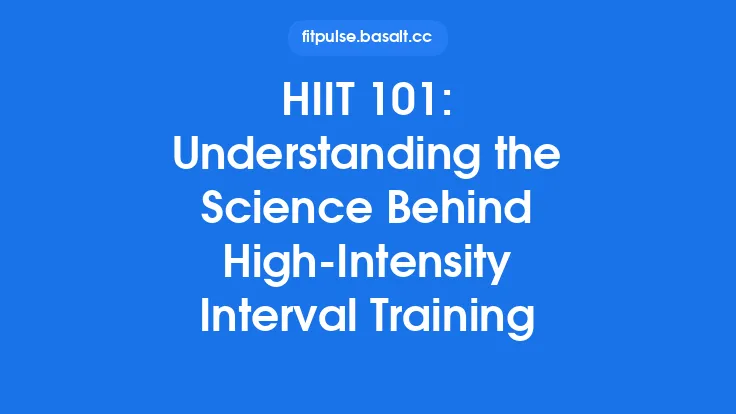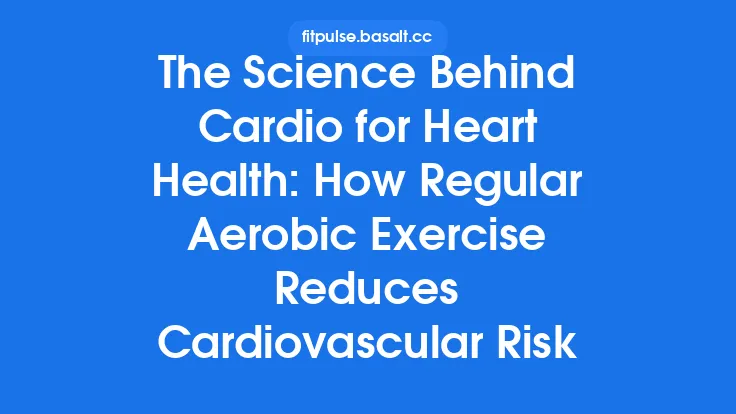Low‑intensity steady‑state (LISS) cardio occupies a unique niche in the spectrum of aerobic training. While it lacks the dramatic time‑efficiency of high‑intensity interval training (HIIT), its physiological footprint is profound and distinct. Understanding the underlying science helps athletes, clinicians, and fitness enthusiasts appreciate why a modest, sustained effort can yield substantial health dividends.
Metabolic Foundations of LISS
At the core of LISS lies a reliance on oxidative metabolism. When exercising at 40–60 % of maximal oxygen uptake (VO₂max), the body can meet ATP demand primarily through the aerobic oxidation of fatty acids and, to a lesser extent, carbohydrates. This contrasts with higher intensities where glycolytic flux and phosphocreatine stores dominate.
- Fatty‑acid oxidation: In the low‑intensity zone, plasma free fatty acids (FFAs) and intramuscular triglycerides become the principal substrates. The rate of lipolysis in adipose tissue rises proportionally with catecholamine release, while muscle uptake is facilitated by increased expression of fatty‑acid transport proteins (e.g., CD36, FATP). The mitochondrial β‑oxidation pathway then converts these FFAs into acetyl‑CoA, feeding the citric acid cycle and oxidative phosphorylation.
- Carbohydrate sparing: Because the relative contribution of glycolysis is modest, muscle glycogen stores are preserved. This “glycogen‑sparing” effect is especially valuable for endurance athletes who need to conserve carbohydrate reserves for later, higher‑intensity efforts.
- Energy balance: Over prolonged sessions (30–90 minutes), the cumulative caloric expenditure can be substantial, and the high proportion of fat-derived calories supports body‑composition goals without the appetite‑stimulating hormonal spikes sometimes observed after intense bouts.
Cardiovascular Adaptations
Repeated LISS sessions elicit a suite of structural and functional changes within the cardiovascular system:
- Stroke volume augmentation: Chronic exposure to sustained volume overload promotes eccentric remodeling of the left ventricle, increasing end‑diastolic volume and thus stroke volume. This improves cardiac output at any given heart rate, lowering the relative effort required for submaximal work.
- Capillary density: Angiogenesis is stimulated by shear stress‑induced up‑regulation of vascular endothelial growth factor (VEGF). The resulting capillary proliferation reduces diffusion distances for oxygen and metabolites, enhancing muscular perfusion.
- Blood pressure modulation: Endothelial nitric oxide synthase (eNOS) activity rises with regular LISS, fostering vasodilation and contributing to modest reductions in resting systolic and diastolic pressures. Longitudinal studies have documented average drops of 4–6 mm Hg in hypertensive cohorts following 12–16 weeks of LISS.
- Heart‑rate variability (HRV): Autonomic balance shifts toward parasympathetic dominance, reflected in increased HRV. This is a marker of improved cardiovascular resilience and reduced arrhythmic risk.
Mitochondrial and Cellular Responses
Mitochondria are the powerhouses that enable sustained aerobic work. LISS uniquely drives mitochondrial biogenesis and functional enhancement:
- PGC‑1α activation: Peroxisome proliferator‑activated receptor gamma coactivator‑1α (PGC‑1α) is a master regulator of mitochondrial gene expression. Low‑intensity, prolonged exercise elevates intracellular calcium and AMP/ATP ratios, activating calcium‑calmodulin‑dependent protein kinase (CaMK) and AMP‑activated protein kinase (AMPK). Both pathways converge on PGC‑1α, stimulating transcription of mitochondrial DNA and nuclear‑encoded oxidative enzymes.
- Oxidative enzyme up‑regulation: Enzymes such as citrate synthase, β‑hydroxyacyl‑CoA dehydrogenase, and cytochrome c oxidase increase in activity, raising the maximal oxidative capacity of skeletal muscle fibers.
- Fiber‑type transitions: Type I (slow‑twitch) fibers expand their oxidative profile, while type IIa fibers acquire more endurance‑like characteristics. This shift improves fatigue resistance across a broader intensity spectrum.
Hormonal and Endocrine Effects
The endocrine milieu during and after LISS differs markedly from that of high‑intensity work:
- Catecholamines: Norepinephrine rises modestly, sufficient to stimulate lipolysis without provoking the cortisol surge associated with high‑stress exercise. This creates a more favorable anabolic‑catabolic balance.
- Insulin sensitivity: Repeated low‑intensity bouts enhance insulin‑stimulated glucose uptake via up‑regulation of GLUT4 translocation. The effect persists for up to 48 hours post‑exercise, contributing to better glycemic control.
- Growth hormone (GH): Although peak GH concentrations are lower than in HIIT, the prolonged duration of LISS yields a comparable total GH exposure, supporting tissue repair and lipolysis.
- Myokine release: Skeletal muscle secretes interleukin‑6 (IL‑6) in an anti‑inflammatory capacity during LISS, which in turn stimulates lipolysis and improves insulin signaling.
Impact on Body Composition and Fat Oxidation
Because LISS preferentially oxidizes fat, it is often employed as a tool for altering body composition:
- Acute fat oxidation rates: Studies using indirect calorimetry show that at ~55 % VO₂max, fat contributes 50–70 % of total energy expenditure, the highest proportion across the intensity spectrum.
- Chronic adaptations: Over weeks to months, the cumulative effect of daily or near‑daily LISS can lead to reductions in visceral adipose tissue (VAT). VAT is metabolically active and linked to cardiometabolic disease; its reduction is a key health outcome.
- Energy‑balance considerations: While LISS alone may not create a dramatic caloric deficit, its low perceived exertion often translates to higher adherence, making it a practical component of long‑term weight‑management strategies.
Influence on Glycemic Control and Insulin Sensitivity
For individuals with impaired glucose tolerance or type 2 diabetes, LISS offers a physiologically sound intervention:
- Glucose uptake: Muscle contraction‑mediated GLUT4 translocation operates independently of insulin, allowing glucose clearance even when insulin signaling is compromised.
- Post‑prandial glucose attenuation: A single 30‑minute LISS session performed within two hours after a carbohydrate‑rich meal can blunt the post‑prandial glucose spike by 15–20 %, as demonstrated in randomized crossover trials.
- Long‑term HbA1c reduction: Meta‑analyses of ≥12‑week LISS programs report average HbA1c reductions of 0.3–0.5 %, comparable to modest pharmacologic interventions.
Neurocognitive and Psychological Benefits
Beyond the peripheral physiological changes, LISS exerts measurable effects on brain function and mood:
- Neurotrophic factors: Brain‑derived neurotrophic factor (BDNF) rises modestly after prolonged low‑intensity exercise, supporting synaptic plasticity and cognitive resilience.
- Stress reduction: The rhythmic, low‑stress nature of LISS promotes parasympathetic activation, lowering cortisol levels and improving subjective stress scores.
- Executive function: Chronic LISS participation has been linked to improvements in attention, processing speed, and working memory, particularly in older adults where aerobic capacity is a predictor of cognitive decline.
Longevity and Disease Prevention
Epidemiological data consistently associate regular moderate‑intensity activity with reduced mortality risk:
- All‑cause mortality: A pooled analysis of cohort studies found that individuals engaging in ≥150 minutes per week of moderate‑intensity activity (the typical LISS prescription) experienced a 20–30 % lower risk of death compared with sedentary peers.
- Cardiovascular disease (CVD): LISS reduces traditional CVD risk factors—blood pressure, LDL cholesterol, triglycerides, and systemic inflammation (CRP). The cumulative effect translates into a measurable decline in incident coronary events.
- Cancer incidence: Moderate aerobic activity is linked to lower rates of colon, breast, and endometrial cancers, possibly mediated by improved insulin sensitivity and reduced adiposity.
Practical Implications for Training Prescription
Translating the science into actionable guidelines requires attention to dose, frequency, and individual variability:
| Variable | Evidence‑Based Recommendation | Rationale |
|---|---|---|
| Intensity | 40–60 % VO₂max (≈ 55–70 % HRmax) | Maximizes fat oxidation while maintaining aerobic stimulus |
| Duration | 30–90 minutes per session | Sufficient time for mitochondrial and cardiovascular adaptations |
| Frequency | 3–5 sessions per week | Balances stimulus with recovery; supports chronic metabolic benefits |
| Progression | Incremental increases in duration (5‑10 % per week) or modest elevation of intensity (5 % VO₂max) | Prevents plateaus in VO₂max and mitochondrial density |
| Modality | Any activity that can be sustained at the target intensity (e.g., brisk walking, light cycling, rowing) | Allows personalization without compromising physiological response |
Monitoring tools such as heart‑rate monitors or wearable VO₂ estimators can help maintain the target intensity zone, but the core principle remains: a steady, comfortable effort that can be sustained for the prescribed duration.
Future Directions and Research Gaps
While the body of evidence supporting LISS is robust, several areas merit deeper investigation:
- Molecular signatures across populations: Most mechanistic studies involve young, healthy adults. Understanding how age, sex, and metabolic health modulate pathways like PGC‑1α activation could refine individualized prescriptions.
- Interaction with nutrition timing: The synergistic effects of nutrient intake (e.g., low‑glycemic vs. high‑glycemic meals) on post‑exercise substrate utilization remain underexplored.
- Hybrid training models: Combining LISS with brief bouts of higher intensity (e.g., “polarized training”) may amplify mitochondrial adaptations while preserving the metabolic benefits of steady‑state work. Controlled trials are needed to delineate optimal ratios.
- Longitudinal cognitive outcomes: While acute neurotrophic responses are documented, the long‑term impact of sustained LISS on neurodegenerative disease progression warrants large‑scale, longitudinal studies.
- Genomic and epigenetic responses: Emerging data suggest that aerobic exercise can induce epigenetic modifications influencing metabolic gene expression. Mapping these changes in response to LISS could unlock new biomarkers of training efficacy.
In sum, low‑intensity steady‑state cardio is far more than a “light” form of exercise. Its distinct metabolic, cardiovascular, mitochondrial, hormonal, and neurocognitive effects create a comprehensive platform for health promotion, disease prevention, and performance enhancement. By grounding training decisions in the underlying science, practitioners can harness LISS as a reliable, sustainable, and scientifically validated pillar of cardiovascular conditioning.





